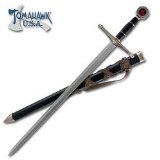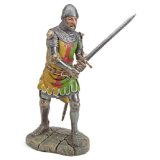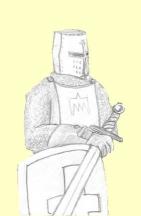A look at some of the weapons that Medieval Knights used
A great portion of a knight’s life was devoted to the mastery of a variety of weapons. Here is a look at some of the more common weapons that were wielded throughout the Middle Ages.
Knights had a reign that lasted several hundred years and in this time period the weapons they used varied and changed significantly. Some of the factors that caused this change were improvements in metalworking and improvements in weapon design. Armor also improved over this period of time and it mandated improvements in weapons. One of the most significant changes came with the advent of plated armor. This new type of armor caused changes in many of the knight’s standard weapons. Slicing and bladed weapons were often accentuated or replaced by weapons that could pierce or apply a hammer-like blow. This development of hand weapons continued to change for centuries and reached its apex in the fourteenth and fifteenth century with the advent of gunpowder. This articles looks at some of the more common weapons from this time period.


 Before gunpowder rendered them obsolete there were basically two different types of weapons that knights used: single-handed, and polearm (two-handed). Of the single-handed weapons the sword is of course the most popular and best known. And it was the beneficiary of technology improvements. Over the centuries they got longer, sharper, lighter, and stronger. They were central part of a knight’s armory and even as hand weapons became obsolete swords remained part of a knights arsenal as a symbol of power and chivalry. (Pictured: Medieval Broadsword with Black Sheath
Before gunpowder rendered them obsolete there were basically two different types of weapons that knights used: single-handed, and polearm (two-handed). Of the single-handed weapons the sword is of course the most popular and best known. And it was the beneficiary of technology improvements. Over the centuries they got longer, sharper, lighter, and stronger. They were central part of a knight’s armory and even as hand weapons became obsolete swords remained part of a knights arsenal as a symbol of power and chivalry. (Pictured: Medieval Broadsword with Black Sheath )
)


Another common one-handed weapon of knights was the mace, which was a short handled striking weapon with a ball on the far end. The ball often had spikes or flanges on it, which would penetrate a foes armor. The flail was another standard weapon and it was short handled with a length of chain then a ball or flail head. This ball on a chain, when swung could generate enormous force, and just as importantly, it could be used to swing up and over an enemy’s shield. The warhammer was another common weapon and it was a direct modification of the blacksmith’s hammer. It was a very common weapon particularly in the early centuries of medieval warfare and was very similar to today’s modern claw hammer having one end that was flat and used for striking, and the other end having a piercing beak that could penetrate armor. (Pictured: Medieval Flange Mace )
)
 Polearms were long handled weapons that knights often used in combat -particularly when mounted on horses. They ranged in length from six feet to as much as twelve or sixteen feet. The basic advantage of a polearm was its reach from atop a horse. It could be used to attack an enemy before he could get close enough to use his own weapon. They came in many variations and the most common type of polearm is the lance, which is still used today in jousting competitions. The lance was also a capable, and feared, weapon used for breaking up the foot ranks of enemy formations. Other types of polearms were often variations of hand-held weapons mounted on the end of a long pole. And two good examples of this are the poleaxe and the halberd, which were forms of axes, often with a hammer, or axe blade along one side and a point at the very tip for penetrating armor. I have an article with lots of pictures describing all the various polearms of the medeival knight.
Polearms were long handled weapons that knights often used in combat -particularly when mounted on horses. They ranged in length from six feet to as much as twelve or sixteen feet. The basic advantage of a polearm was its reach from atop a horse. It could be used to attack an enemy before he could get close enough to use his own weapon. They came in many variations and the most common type of polearm is the lance, which is still used today in jousting competitions. The lance was also a capable, and feared, weapon used for breaking up the foot ranks of enemy formations. Other types of polearms were often variations of hand-held weapons mounted on the end of a long pole. And two good examples of this are the poleaxe and the halberd, which were forms of axes, often with a hammer, or axe blade along one side and a point at the very tip for penetrating armor. I have an article with lots of pictures describing all the various polearms of the medeival knight.
Some Other Weapons of the Medieval Knight
- Axe - This was an effective weapon in that it had a blade on one side and a hammer or pick on the other for a variety of striking options. It also often had a piercing point at the bottom of the handle for close in fighting. .
- Halberd - This was a polearm weapon that was often six feet long or more. It was an effective weapon in that it often had a slicing blade like an axe, a pointed end for stabbing and a hook for pulling at the opponent.

 While there were many weapons that knights used there also were a few weapons that they refused to use for various reasons. Knighthood came with a complete code of conduct and a rule of chivalry and these had an effect on the weapons they could use. The three most popular weapons that they didn’t use were the bow, the crossbow, and the dagger. The bow and crossbow were considered to be unknightly because you did not face your foe when fighting. And the dagger was considered to be a dishonorable weapon because it was used stealthily and hidden; although, the dagger did start to become a sometimes-used weapon toward the end of the middle ages but it predominantly for ceremonial purposes only. (Pictured: Medieval Knight in Suit of Chain and Plate Mail Armor Wielding a Sword - Hand Painted Full Color Statue - Very Detailed
While there were many weapons that knights used there also were a few weapons that they refused to use for various reasons. Knighthood came with a complete code of conduct and a rule of chivalry and these had an effect on the weapons they could use. The three most popular weapons that they didn’t use were the bow, the crossbow, and the dagger. The bow and crossbow were considered to be unknightly because you did not face your foe when fighting. And the dagger was considered to be a dishonorable weapon because it was used stealthily and hidden; although, the dagger did start to become a sometimes-used weapon toward the end of the middle ages but it predominantly for ceremonial purposes only. (Pictured: Medieval Knight in Suit of Chain and Plate Mail Armor Wielding a Sword - Hand Painted Full Color Statue - Very Detailed )
)
The use of weapons by knights over the course of the Middle Ages changed and evolved significantly based on many factors such as blacksmithing skills, engineering skills, improvements in armor, improvement in combat techniques, and even the code of chivalry. While many variations of weapons came and went there were only about a dozen trusted weapons that had proven their worth through centuries of use on the battlefield.
Resources

I have lots of interesting articles about knights, their weapons and their organizations right here: Articles about Knights






